 W
WThe Buddhist Caves in Ajanta are approximately 30 rock-cut Buddhist cave monuments dating from the 2nd century BCE to about 480 CE in the Aurangabad district of Maharashtra state in India. The caves include paintings and rock-cut sculptures described as among the finest surviving examples of ancient Indian art, particularly expressive paintings that present emotions through gesture, pose and form.
 W
WAnangpur is a historical village located near Faridabad in Haryana, India. Anangpur forms a geographical triangle along with Mehrauli and Tugluqabad. It was the earliest settlement of the Tomara dynasty. Anangpur was the capital of the Tomar king, Anangpal Tomar.
 W
WThe Badami cave temples are a complex of Hindu and Jain cave temples located in Badami, a town in the Bagalkot district in northern part of Karnataka, India. The caves are important examples of Indian rock-cut architecture, especially Badami Chalukya architecture, and the earliest date from the 6th century. Badami is a modern name and was previously known as Vataapinagara, the capital of the early Chalukya dynasty, which ruled much of Karnataka from the 6th to the 8th century. Badami is situated on the west bank of a man-made lake ringed by an earthen wall with stone steps; it is surrounded on the north and south by forts built in later times.
 W
WThe Bagh Caves are a group of nine rock-cut monuments, situated among the southern slopes of the Vindhyas in Bagh town of Dhar district in Madhya Pradesh state in central India. These monuments are located at a distance of 97 km from Dhar town. These are renowned for mural paintings by master painters of ancient India. The use of the word "cave" is a bit of a misnomer, since these are not natural, but instead examples of Indian rock-cut architecture.
 W
WThe Barabar Hill Caves are the oldest surviving rock-cut caves in India, dating from the Maurya Empire, some with Ashokan inscriptions, located in the Makhdumpur region of Jehanabad district, Bihar, India, 24 km (15 mi) north of Gaya.
 W
WBava Pyara caves are an example of ancient man-made caverns. The caves are a part of the Junagadh Buddhist Cave Groups situated in the eastern part of Junagadh of the Indian state of Gujarat. Bava Pyara caves contains artworks of both Buddhism and Jainism.
 W
WBedse Caves are a group of Buddhist rock-cut monuments situated in Maval taluka, Pune District, Maharashtra, India. The history of the caves can be traced back to the Satavahana period in the 1st century BCE. They are some 9 km from the Bhaja Caves. Other caves in the area are Karla Caves, Patan Buddhist Cave and Nasik Caves.
 W
WThe Belum Caves is the largest and longest cave system open to the public on the Indian subcontinent, known for its speleothems, such as stalactite and stalagmite formations. The Belum Caves have long passages, galleries, spacious caverns with fresh water and siphons. This cave system was formed over the course of tens of thousands of years by the constant flow of underground water from the now-disappeared river Chitravathi. The cave system reaches its deepest point at the point known as Pataalaganga. In Telugu language, it is called Belum Guhalu. Belum Caves have a length of 3,229 m (10,593.8 ft), making them the second largest caves on the Indian Subcontinent after the Krem Liat Prah caves in Meghalaya. It is one of the centrally protected Monuments of National Importance.
 W
WThe Bhimbetka rock shelters are an archaeological site in central India that spans the Paleolithic and Mesolithic periods, as well as the historic period. It exhibits the earliest traces of human life in India and evidence of Stone Age starting at the site in Acheulian times. It is located in the Raisen District in the Indian state of Madhya Pradesh about 45 kilometres (28 mi) south-east of Bhopal. It is a UNESCO World Heritage Site that consists of seven hills and over 750 rock shelters distributed over 10 km (6.2 mi). At least some of the shelters were inhabited more than 100,000 years ago. The rock shelters and caves provide evidence of, according to Encyclopædia Britannica, a "rare glimpse" into human settlement and cultural evolution from hunter-gatherers, to agriculture, and expressions of prehistoric spirituality.
 W
WBinnayaga Buddhist Caves also known as Vinayaka or Vinayaga are located at village Binnayaga in the state of Rajasthan, India. The excavation has around 20 laterite caves facing south from east to west. This is monastic complex, the cells are smaller than Kolvi Caves cell. The stupa shaped sanctuary is the highlight of these caves. It has chaitya which bears windows. Another significant cave has two wings of an open courtyard. "It has at the back a closed lobby with vaulted ceiling and a central door flanked by a cell on either side. The moulded pedestal against the back wall is now empty."
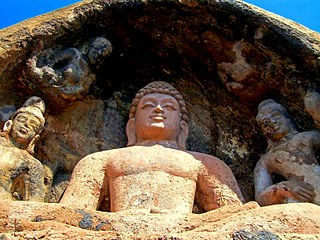 W
WBojjannakonda and Lingalakonda are two Buddhist rock-cut caves on adjacent hillocks, situated near a village called Sankaram, which is a few kilometres away from Anakapalle, Vishakhapatnam in the Indian state of Andhra Pradesh. The sites are believed to date between 4th and 9th Century A.D, when Buddhism is the majority religion of Sankaram. The original name of Bojjannakonda is Buddina Konda.
 W
WChandavaram Buddhist site is an ancient Buddhist site in Chandavaram village in Prakasam district in the Indian state of Andhra Pradesh. Situated on the bank of Gundlakamma River, the site is 10 kilometres (6.2 mi) northwest of Donakonda railway station. The Chandavaram Buddhist site was built between the 2nd century BCE and the 2nd century CE during the Satavahana dynasty and was discovered by Dr. Veluri Venkata Krishna Sastry in 1964.
 W
WThe Dhamnar Caves are caves located in the village of Dhamnar, located in Mandsaur district in the state of Madhya Pradesh, India. This rock cut site consists of 51 caves, stupas, Chaityas, passages, and compact dwellings, carved in the 7th century CE. The site includes large statues of Gautama Buddha in sitting and Nirvana mudra.
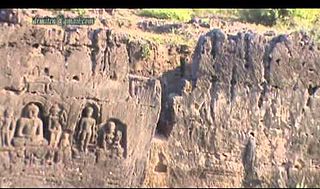 W
WThe Dhank Caves are located near Dhank village near Upleta, Rajkot district, Gujarat, India. They were chiseled out of a calcareous sandstone outcropping during the regime of the Western Satraps. The caves are influenced by Buddhist and Jain cultures. The Jain cave includes figures of Adinath, Shantinath and Pārśva. These are considered to be the earliest Jain sculptures in Kathiawad.
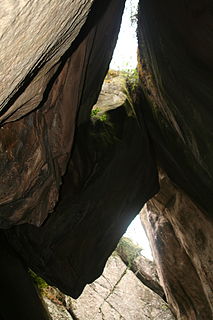 W
WEdakkal Caves are two natural caves at a remote location at Edakkal, 25 km (15.5 mi) from Kalpetta in the Wayanad district of Kerala in India's Western Ghats. They lie 1,200 m (3,900 ft) above sea level on Ambukutty Mala, near an ancient trade route connecting the high mountains of Mysore to the ports of the Malabar coast. Inside the caves are pictorial writings believed to date to at least 6,000 BCE, from the Neolithic man, indicating the presence of a prehistoric settlement in this region. The Stone Age carvings of Edakkal are rare and are the only known examples from South India besides those of Shenthurini, Kollam also in Kerala.
 W
WDesignated by UNESCO as a World Heritage Site, the Elephanta Caves are a collection of cave temples predominantly dedicated to the Hindu god Shiva. They are on Elephanta Island, or Gharapuri, in Mumbai Harbour, 10 kilometres (6.2 mi) east of Mumbai in the Indian state of Mahārāshtra. The island, about 2 kilometres (1.2 mi) west of the Jawaharlal Nehru Port, consists of five Hindu caves, a few Buddhist stupa mounds that date back to the 2nd century BCE, and two Buddhist caves with water tanks.
 W
WEllora is a UNESCO World Heritage Site located in the Aurangabad district of Maharashtra, India. It is one of the largest rock-cut Hindu temple cave complexes in the world, featuring Buddhist and Jain monuments with artwork dating from the period 600–1000 CE. Cave 16 features the largest single monolithic rock excavation in the world, the Kailash temple, a chariot shaped monument dedicated to Lord Shiva. The Kailash temple excavation also features sculptures depicting the gods, goddesses found in Hinduism as well as relief panels summarizing the two major Hindu Epics.
 W
WErravaram Caves are located on the left bank of Yeleru river, at a distance of 45 km from Rajahmundry on Vishakhapatnam route. The caves are located on Dhanla–dibba hillock. The excavations revealed historic remains dated back to 100 A.D. This site flourished from 1st century B.C. to 2nd century A.D.
 W
WGandharpale Caves, also called Mahad caves or Pandava Leni, is group of 30 Buddhist caves, 105 km south of Mumbai on Mumbai-Goa Highway near Mahad. The caves are located near the NH-17 and well connected by road.
 W
WThe Ghatotkach Caves are located 18 km to the west of Ajantha, near Jinjala village, India. The caves include three Buddhist caves, one is a chaitya and two are viharas. The caves were excavated in the 6th century AD, and were influenced by Mahayana Buddhism.
 W
WThe Ghorawadi caves, also known as Ghoradeshwar caves or Shelarwadi caves, are around 25 km (16 mi) northwest of Pune, India, were originally Buddhist caves, and now contain carvings and statues of Buddhist and Hindu deities.
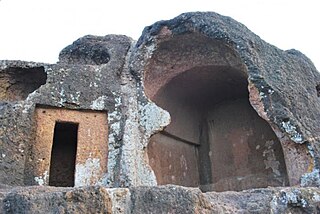 W
WHathiagor Buddhist Caves are located at village Pagaria in the state of Rajasthan, India. The caves are located on hill called Hathiagor-ki-Pahadi. The group has five caves measuring 5 m x 5 m x 7 m. A stupa is located closer to the caves.
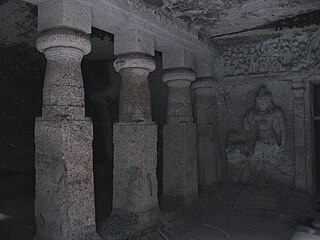 W
WThe Jogeshwari Caves are some of the earliest Buddhist cave temples sculptures located in the Mumbai suburb of Jogeshwari, India. The caves date back to 520 to 550 CE. These caves belongs to the Hindus daity Jogeshwari]]. According to historian and scholar Walter Spink, Jogeshwari is the earliest major cave temple in India and "the largest".
 W
WThe Sitabenga and Jogimara Caves, sometimes referred to either as Sitabenga Cave or Jogimara Cave, are ancient cave monuments nested in the north side of Ramgarh hills in Puta village, Chhattisgarh, India. Dated between the 3rd-century BCE to 1st-century BCE, they are notable for their non-religious inscriptions in Brahmi script and Magadhi language, and one of the oldest colored frescoes in Asia. Some scholars state that the Sitabenga cave is the oldest performance theatre on the Indian subcontinent, but others question whether it was indeed a theatre and suggest that it may have been a resting place (dharmashala) along an ancient trade route. The inscription at the Jogimara cave is equally disputed, with one translation interpreting it as a love-graffiti by a girl and a boy, while another translation interpreting it as a female dancer and a male sculptor-painter creating the two caves together to serve others. The inscription is also the oldest known mention of the word "devadasi", but this seems just a name and it is unlikely that this was related to any ancient Indian temple since the site and nearby area has no evidence of any Buddhist, Hindu or Jain temple built between the 3rd-century BCE and 8th-century CE.
 W
WJunagadh Buddhist Cave Groups are located in Junagadh district of the Indian state of Gujarat. These caves group includes Uparkot Caves, Khapra Kodiya Caves and Baba Pyare Caves. The so-called "Buddhist Caves" are not actually caves, but three separate sites of rooms carved out of stone to be used as monks' quarters. These caves were carved starting from Emperor Ashoka's period up to 1st–4th century AD.
 W
WKadia Dungar Caves are located at Kadia Dungar near Zazpor village of Zagadiya Taluka of in Bharuch district of the Indian state of Gujarat. The group has seven caves carved out in 1st and 2nd century AD on the mountain. The group includes sculpture of monolithic lion pillars. An architecture of cave shows vihara style construction. The site has a brick stupa at the foot of a mountain. The caves were carved out in 1st or 2nd century AD, influenced by Buddhist architecture.
 W
WKanjur or Kanchiyur is a hamlet in Gingee taluk in Villuppuram district in the Indian state of Tamil Nadu. The major occupation of the people living at this place is agriculture. In 2011 it had a population of 400.
 W
WThe Kanheri Caves are a group of caves and rock-cut monuments cut into a massive basalt outcrop in the forests of the Sanjay Gandhi National Park, on the former island of Salsette in the western outskirts of Mumbai, India. They contain Buddhist sculptures and relief carvings, paintings and inscriptions, dating from the 1st century CE to the 10th century CE. Kanheri comes from the Sanskrit Krishnagiri, which means black mountain.
 W
WThe Karad Caves form a group of 66 Buddhist caves located about 5 kilometers south west of Karad, near the village Jakhinwadi overlooking the Koyna River. They are composed of:Agashiv Caves 17.2352778°N 74.1522222°E Bhairav Caves 17.239268°N 74.148289°E Dongrai Caves 17.2551854°N 74.1634643°E)
 W
WThe Karla Caves, Karli Caves, Karle Caves or Karla Cells, are a complex of ancient Buddhist Indian rock-cut caves at Karli near Lonavala, Maharashtra. It is just 10.9 Kilometers away from Lonavala. Other caves in the area are Bhaja Caves, Patan Buddhist Cave, Bedse Caves and Nasik Caves. The shrines were developed over the period – from the 2nd century BCE to the 5th century CE. The oldest of the cave shrines is believed to date back to 160 BCE, having arisen near a major ancient trade route, running eastward from the Arabian Sea into the Deccan.
 W
WKhed Caves, also Bouddh Caves, are a series of ancient Buddhist caves in the city of Khed, Maharashtra, India.
 W
WKolvi Caves or Kholve Caves, are located at Kolvi village in the state of Rajasthan, India. They are carved out in laterite rock hill. This Buddhist site has stupas, chaityas containing figures of Buddha. An architectural style shows dominance of Hinayana sect in this region. The caves has statues of Buddha in the meditation and standing position. The stupas and colossal statues of Buddha are archaeologically significant. Around Kolva village similar caves have been discovered which proves existence of prosperous Buddhist civilization in the region.
 W
WThe Kondana Caves are located in the small village of Kondana, 33 km north of Lonavala and 16 km northwest of Karla Caves. This cave group has 16 Buddhist caves. The caves were excavated in first century B.C. The construction on wooden pattern is notable. One can reach the cave by descending from Rajmachi village.
 W
WKuda Caves are located in the small village of Kuda, on the eastern side of the north shore of Murud-Janjira in south Konkan, India. These fifteen Buddhist caves are small, simple, and were excavated in first century BCE.
 W
WLenyadri, sometimes called Ganesa Lena, Ganesh Pahar Caves, are a series of about 30 rock-cut Buddhist caves, located about 4.8 kilometres (3.0 mi) north of Junnar in Pune district in the Indian state of Maharashtra. Other caves surrounding the city of Junnar are: Manmodi Caves, Shivneri Caves and Tulja Caves. The Lenyadri caves date between the 1st and 3rd century AD and belong to the Hinayana Buddhism tradition.
 W
WThe Mahakali Caves, also Kondivite Caves, are a group of 19 rock-cut monuments built between 1st century BCE and 6th century CE.
 W
WThe Mandapeshwar Caves is an 8th Century rock-cut shrine dedicated to Shiva located near Mount Poinsur in Borivali, a suburb of Mumbai in Maharashtra, India. The caves were originally Buddhist viharas.
 W
WThe Manmodi Caves are a complex of a rock-cut caves about 3 km to the south of the city of Junnar in India. Other caves surrounding the city of Junnar are: Tulja Caves, Shivneri Caves and Lenyadri caves.
 W
WThe Nasik Caves or Trirashmi Leni, are a group of 23 caves carved between the 1st century BCE and the 3rd century CE, though additional sculptures were added up to about the 6th century, reflecting changes in Buddhist devotional practices. The Buddhist sculptures are a significant group of early examples of Indian rock-cut architecture initially representing the Hinayana tradition.
 W
WMangar Bani, a paleolithic archaeological site and sacred grove hill forest next to the Mangar village on Delhi-Haryana border, is in the South Delhi Ridge of Aravalli mountain range in Faridabad tehsil of Faridabad district in the Indian state of Haryana. It lies, immediate south of India's national capital Delhi, within NCR.
 W
WNenavali Caves, also Khadsamble Caves, are located at Sudhagad at Raigad, India. This is group of 37 Buddhist caves about 35 km from Pali, carved in first century B.C.
 W
WPanhalakaji Caves are situated in the Ratnagiri district of Maharashtra state, about 160 km south of Mumbai. This cave complex has around 30 Buddhist caves. The Hinayana sect began carving caves in 3rd century AD, beginning with the stupa in the current Cave 5. The caves have inscriptions in Brahmi and Devanagari script. In the 10-11th century AD another Buddhist group, a Vajrayana sect, established cave 10 with their deities Akshobhya and Mahachandaroshana; and strengthened their practice in that region. Shiva and Ganpatya worshiping started at the site during Silahara rule. There are total 29 caves out of which 28 are situated on the right bank of mou tain stream Kotjai.
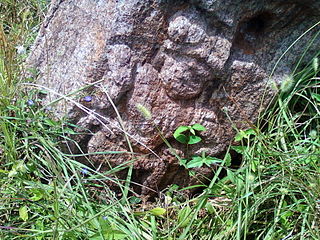 W
WPavurallakonda or Pavurallabodu is the local name of a hill, popularly known as Narasimhaswamy Konda, near Bheemunipatnam about 25 km towards north of Visakhapatnam, in the Indian state of Andhra Pradesh. It is located at a height of about 150 meters above mean sea level.
 W
WPohale Caves, also Pohala Caves or Pawala Caves, are a group of Buddhist caves located in Kolhapur District, Maharashtra, India, after 15km northeast of Kolhapur.
 W
WThere are two sets of Buddhist caves in two different places taking the name of Shana caves.
 W
WSaptparni Cave, also referred to as Sapta parni guha (Saraiki) or sattapaṇṇi guhā (Pali), literally Seven-leaves-cave, is a Buddhist cave site about 2 kilometres (1.2 mi) southwest from Rajgir, Bihar, India. It is embedded in a hill. The Saptaparni Cave is important in the Buddhist tradition, because many believe it to be the site in which Buddha spent some time before his death, and where the first Buddhist council was held after Buddha died (paranirvana). It is here that a council of few hundred monks decided to appoint Ananda, Buddha's cousin, and Upali, who had accompanied the Buddha when he gave sermons in north India, to compose Buddha's teachings for the future generations. This was of special importance because the Buddha never wrote down his teachings. After the meeting in Saptaparni Cave, Ananda created an oral tradition of Buddha's teaching from his memory, prefacing it with "Thus have I heard on one occasion". Upali is credited with reciting the Vinaya (discipline), or "rules for the Bhikshus". This tradition is found in Vinaya Pitaka II.284 through II.287 and Digha Nikaya II.154.
 W
WSaru Maru is the archaeological site of an ancient monastic complex and Buddhist caves. The site is located near the village of Pangoraria, Budhani Tehsil, Sehore District, Madhya Pradesh, India. The site is about 120 km south of Sanchi.
 W
WShirwal Caves are a group of 15 Buddhist caves located in a small village called Shriwal, 48 km south of Pune, India.
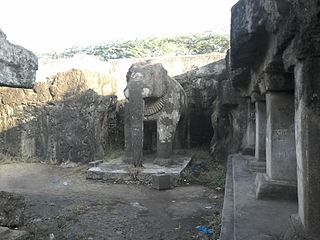 W
WThe Shivleni Caves in Ambajogai, Maharashtra, India are rock-cut cave monuments which date in King Udayaditya from Paramara dynasty of Malwa. Total excavations were hewn out of rock cut and carved deep inside the hill. The caves include sculptures of Hindu deities like Shiva, Saptamatrukas and Ganesha.
 W
WThe Shivneri Caves are artificial caves dug for Buddhist monks circa the 1st century CE. These are now famous tourist attractions located on Shivneri Hill, about 2 km Southwest of Junnar, India. Other caves around the city of Junnar are: Manmodi Caves, Lenyadri, and the Tulja Caves.
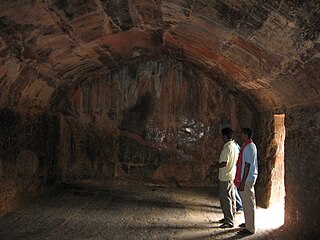 W
WThe Son Bhandar caves, also Sonebhandar, are two artificial caves located in Rajgir in the state of Bihar in India. They belonged to the Jains. The caves are generally dated to the 3rd or 4th century CE, based on the dedicatory inscription found in the largest cave which uses Gupta script of the 4th century CE, although some authors have suggested the caves could actually go back to the period of the Maurya empire from 319 to 180 BCE. The main cave is rectangular with a pointed ceiling, and the entrance is trapezoidal, reminiscent of the structure of the Barabar Caves. The quality of the "Mauryan polish" and the finish are nevertheless much inferior. The stone of Son Bhandar is also much less hard than the granite of the Barabar caves, and therefore did not require the same degree of effort and technique.
 W
WThe Talaja Caves are located in Bhavnagar district of the Indian state of Gujarat at Talaja. The rock cuts are carved out into deserted conical rocks. The rock cut group include 30 caves among which about 15 are water tanks. The cave has unique architecture known as Ebhal Mandapa. The halls are plain. "On the facade there are chaitya windows with a broad bank below them." The chaitya and cells were carved during Buddhism influence in 2nd century BC.
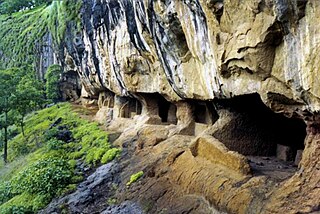 W
WThanale Caves or Nadsur Caves is a group of 23 Buddhist caves located 72 km (45 mi) to the southeast of Mumbai, in western Maharashtra, India, at Thanale Village, Taluka Sudhagad in Raigad, 18 km from Pali.
 W
WTulja Caves are located beyond the Shivneri hill, about 4km to the west of Junnar, India. Other caves surrounding the city of Junnar are: Manmodi Caves, Shivneri Caves and Lenyadri caves.
 W
WVikramkhol or Bikramkhol cave is a prehistoric archaeological site known for prehistoric inscriptions.
 W
WYerphal Caves, also Yerphale Caves, are a small group of Buddhist caves located near Umbraj, Maharashtra, India. The caves were only discovered recently, in 1979. It is located not far from the Karad Caves.